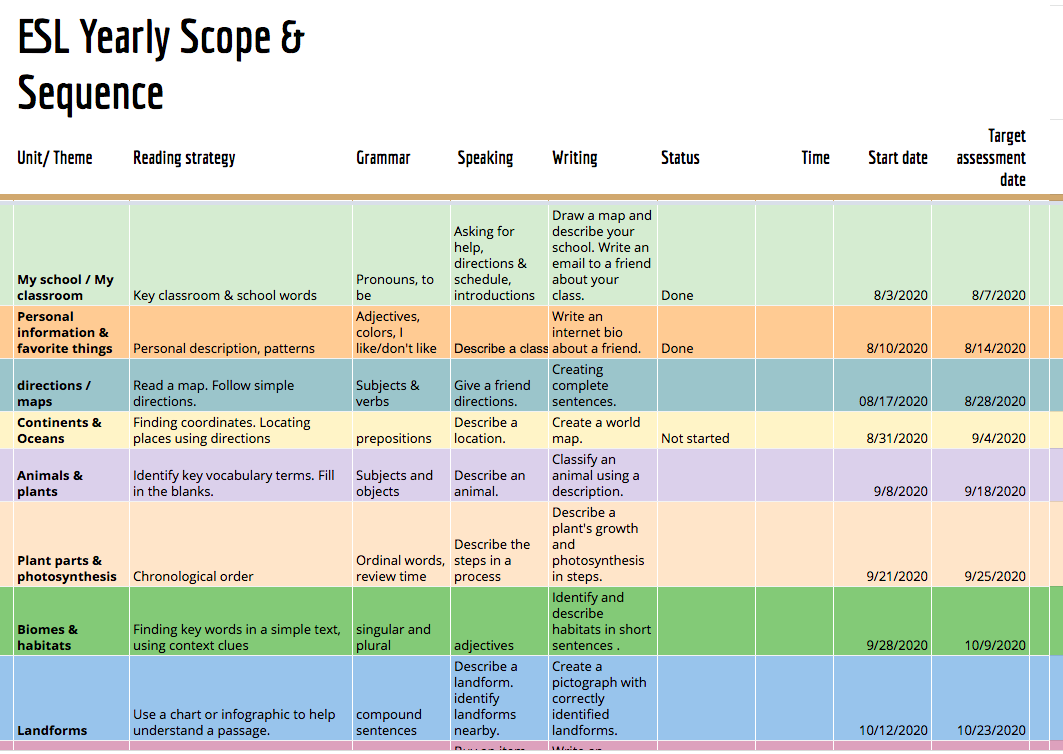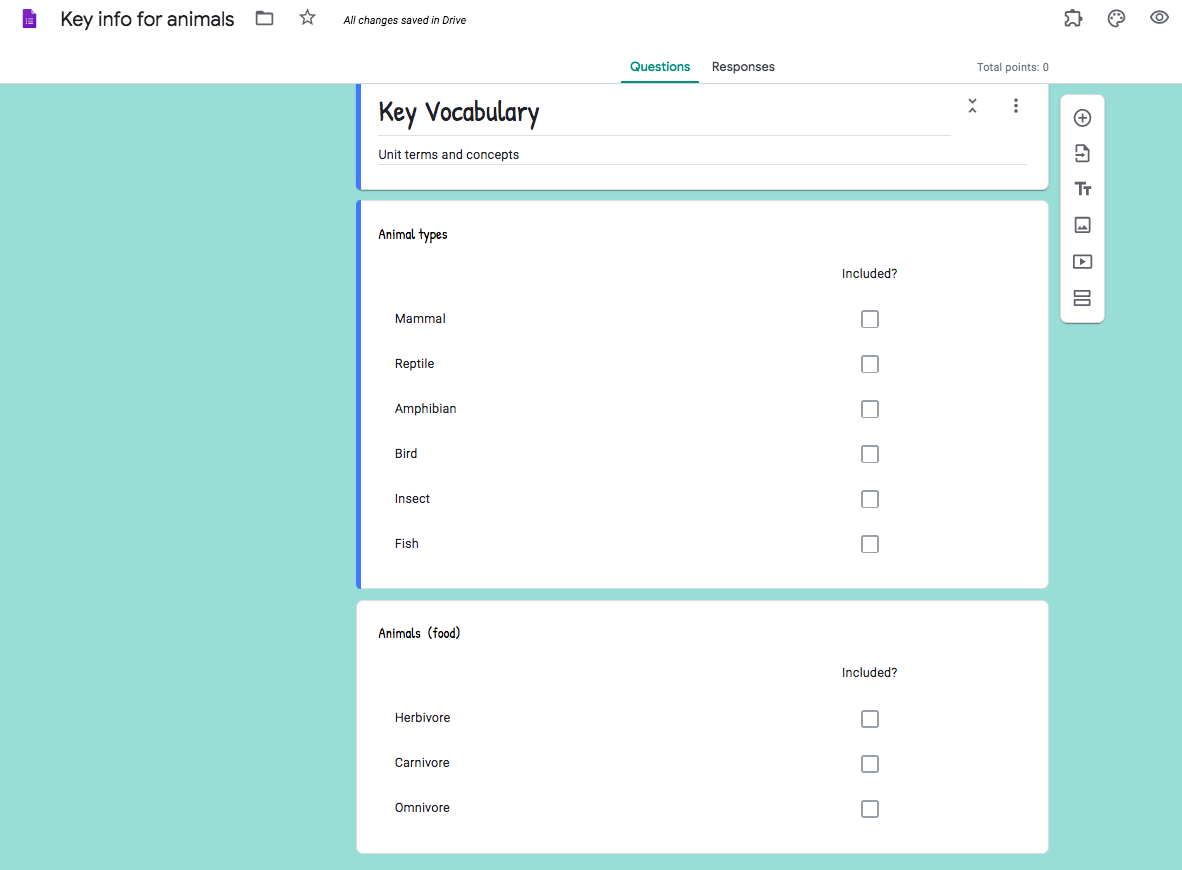Planning ESL Lessons: the big picture
Written by a Mandy Wade, a ReadTheory user, and a high-school ESL teacher
Every learning situation for English Learners is unique. Whether you are teaching academic subjects with multilingual learners integrated into your classroom, or if you are serving students as a content or language expert for students who are learning English, the goal is the same: language proficiency. So how do teachers plan what to teach?
Learning English and becoming academically fluent is not a task that can be accomplished in a short period of time. With a scope of information so broad, how can teachers know where to begin? The key is planning and grouping topics to make learning time as effective and efficient as possible.
An effective English Language Development curriculum should:
- Provide systematic, explicit, and sustained language instruction — This means that learning should be organized with a specific goal in mind. Jumping around thematically doesn’t allow students to master concepts. Students should be provided with explanations, examples and practice for each topic.
- Prepare students for general education by focusing on academic language while also attending to social instructional language — Teachers need to address the content area vocabulary that students are expected to know for each grade level. Even if students are unable to master complex concepts in English, by introducing and practicing content vocabulary, students will develop a foundation for later learning. Students should also practice the language of the classroom so they can follow directions and understand what is being expected.
- Build on the language, experiences, knowledge, and interests that students bring to school — By using what the students already know, students are not starting from zero. Students generally already know how to interact in the first language. By giving them the English words to describe what they already know, learning is simplified to remembering the right words to use in a familiar situation.
Planning ESL Instruction: the Standards
Most public schools in the United States use some form of English Development Standards developed by a group called WIDA. WIDA (World-class Instructional Design and Assessment) is a consortium of 35 states that design learning targets, materials and assessments for English language learners. They measure proficiency through listening, speaking, reading and writing skills.
Teachers outside of the consortium or outside of the U.S. can use the P-12 standards from International TESOL. The International group of Teachers of English for Speakers of Other Languages has five key standards that English language learners communicate information, ideas, and concepts necessary for academic success in each of the academic content areas.
Both the WIDA and TESOL standards are extremely broad and deliberately vague, in order for teachers to pair them with other standards. In fact, TESOL specifically addresses this with its description, stating that the standards were designed to “expand the scope and breadth of the ESL content standards by bridging them to specific core curriculum content areas, namely, English language arts, mathematics, science, and social studies.”
The Language Development standards are not something to be covered once and then checked off a list. In fact, each one will be addressed repeatedly during a year. With so much to cover, planning is essential to make sure that time is used wisely.
In this example of a yearly (below) learning scope and sequence, students cover content area topics thematically that are matched to similar grade level target concepts. High schools generally require students to take Environmental / Earth Science, Biology and World History (or Geography).
I collaborated with other content teachers while developing a yearly plan, and chose subjects that fit as pre-teaching concepts for those subjects, as well as covering ESL language acquisition standards.
Within these topics, teachers can embed learning practice in a range of concepts such as pronunciation, articulation, listening fluency, reading comprehension and writing skills.
I check in with my colleagues regularly to gather feedback on what has worked, and what needs to be changed, gaging the pace of the class based on the academic needs of the students. Here is one example of a yearly plan.

Weekly planning: an optimistic approach
Experienced teachers know that even the best created plans leave room for flexibility and adjustment. By planning on a weekly basis, time can be reorganized as needed for remediation or additional practice. Within thematic units, break down the material into sections that can be reasonably covered and practiced in approximately one to two weeks.
First, begin by making a list of the key vocabulary and essential concepts that need to be covered within that theme. Start by creating a checklist.

Next, create the assessment that measures mastery of the desired content, and then you should make your plans by working backward. It is important to know the destination before starting the learning journey!
Practice materials should be informal assessments to know what has been mastered, and to give you an idea when to move on. These provide plenty of ways to meet language goals with listening, reading, writing and speaking practice. Keep in mind the amount of seat time you have with these students each week, as this may vary greatly between grades.
As the year progresses teachers should break the yearly plan into weekly plans. The weekly plan may include an entire unit or just one part. An example week can be taken from part of the animal classification unit, and turned into a weekly plan.
There are an enormous variety of lesson plan templates available online, so don’t feel trapped into a specific style that doesn’t work for you. As the weekly plan from the animals unit is broken down to a daily plan, general parts that should be included are an essential question or learning target (what you want students to learn that day), state/national standards that match with your learning goals, a warm up, activities, formal / informal assessments and a wrap up / review time. Some schools also suggest including any special accommodations that students may require.
To promote active learning from attentive students, activities should last no longer than 10-15 minutes for younger students and 15-20 min for older students. Alternate activities that require interaction and movement with those that require individual concentration. To keep on track, set a timer. You can always come back to the activity later.

Use what works for you; change what doesn’t
Depending on the needs of the students, teachers may choose lesson plan styles that are more tailored to a specific activity or learning style. There are many different examples, and many of them are available for free online. Here are a few of my favorites:
- ESL Science: Space — The sun, moon, stars and planets
- World History: Creating a “Back Door” ESL world history lesson
- Drama: Writing English Drama Scripts in ESL Class
- ESL Social Studies: Comparing Countries
- Speaking: Teaching Telephone English
- Introductions: Introduce yourself
- Media Awareness: The Basics of Advertising
- ESL Listening: Listening Comprehension Related to Jobs
- Current Events: Breaking News English (Leveled news articles)
Six ESL Activities you can use in your next lesson
- Vocabulary Build It — Use Legos or modeling clay to construct a representation of a vocabulary word or concept. Students can work individually or in teams.
- What Am I Thinking Of ? — Similar to Twenty Questions, the students take turns asking questions to figure out the vocabulary term or concept that the teacher has chozen. Students practice categorization and grouping to determine an answer.
- Scavenger Hunt — Students use clues in English to locate objects, places or people within the school.
- Who Did It? Detective Style Logic — Students use questioning and logic skills to determine which student is guilty of committing a “crime”.
- Your Dream Job: Interview Practice — Students will research their dream job and prepare to be interviewed for that job. The student’s partner will conduct the interview, and students will vote on who should be hired.
- ABC Story — How well do your students know their ABCs? Instead of a normal story, students create a story with each sentence consecutively from A to Z.

Content Area Passages to Kick Off Learning
ReadTheory has printable reading passages that are specifically adapted to fit an ESL student’s proficiency level. These can be used individually, as a large group or in reading pairs. Interesting content area topics can get a unit started or provide an easy assessment tool for reading comprehension checks. Simply sign up to ReadTheory to access many more worksheets online. Here are five that I like best:
Prepare Ahead for Online Learning
Preparing yourself and your students for online learning has become the “new normal” in order to create a successful learning environment. Online learning can be a scary prospect for teachers of English Learners, and the students, too. For ideas about where to start with English Learners, take time to review my article on Remote ESL Learning. It contains additional tips for keeping students interested in learning, as well as overcoming obstacles that may keep students from interacting. Additionally, Dean Deaver walks teachers through planning online lessons, including the pros and cons of videos vs. live sessions in his recent article.
Every teacher must be ready to utilize distance learning now, as well as for classes that are scheduled for upcoming terms. How can we be ready?
- Know what platforms you plan to use — Set up accounts on ReadTheory, Zoom, Google Classroom, Canvas, Rosetta Stone or whatever platforms you plan to use regularly. Plan out how you intend to use each piece to make your learning most efficient.
- Set up accounts for your students and give them hands-on practice — If at all possible, have your students get used to the programs while they can have direct contact with a teacher. Students are less likely to use a platform if they have never tried it before.
- Provide everyone with a cheat sheet — Give students and all co-teachers / paraprofessionals notes with simple directions, pictures and any key information they need to log in to each program. The students should know how to check their own email to get information, too.
- Make regular contact — Set up regular video meetings, and record them for students who can’t attend live. Email, call or message your students and their parents, regularly so they know they can ask questions and get help when they need it.



